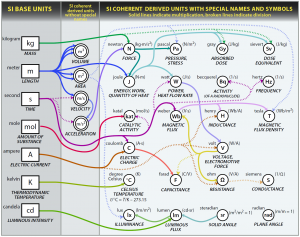1.4 Learning Obstacles and Helps
If you are not comfortable with the foundational principles of math, soil science, or physics, you may benefit from studying resources such as:
- the SSSA Glossary of Soil Science Terms (link)
- Daniels and Haering’s “Concepts of Basic Soil Science” (link)
- the “Math Skills Review” by Keeney-Kennicutt (link)
- the Khan Academy video series on Physics (link)
For students in the United States, one of three countries in the world that has not adopted the International System of Units (SI units), this book’s use of SI units may be a learning obstacle. The SI units diagram below (Fig. 1‑1) provides a helpful visual overview of the seven SI base units and the associated derived units. Derived units that we will use in this book include newtons (N), pascals (Pa), joules (J), watts (W), degree Celsius (°C), and siemens (S).

To use SI units effectively requires knowing and understanding the SI unit prefixes, which modify the magnitude of the units. The most common SI prefixes are listed in Table 1‑1. Being familiar with these prefixes will help you correctly understand the size or intensity of the physical variables we will be studying throughout the book.
Table 1‑1. Common SI prefixes. Adapted from Wikipedia (link). CC BY-SA 3.0.
| Text | Symbol | Factor | Power |
| peta | P | 1000000000000000 | 1015 |
| tera | T | 1000000000000 | 1012 |
| giga | G | 1000000000 | 109 |
| mega | M | 1000000 | 106 |
| kilo | k | 1000 | 103 |
| hecto | h | 100 | 102 |
| deca | da | 10 | 101 |
| (none) | (none) | 1 | 100 |
| deci | d | 0.1 | 10-1 |
| centi | c | 0.01 | 10−2 |
| milli | m | 0.001 | 10−3 |
| micro | μ | 0.000001 | 10−6 |
| nano | n | 0.000000001 | 10−9 |
| pico | p | 0.000000000001 | 10−12 |
| femto | f | 0.000000000000001 | 10−15 |
A related challenge for many students is unit conversion. For example, students in the US often need to convert from customary US units to those of the SI system. Many online unit conversion tools are now available, and in fact, the desired conversion can often be found by typing a phrase like “convert 3.7 inches to centimeters” into the search bar of a web browser. Still it is helpful to know some basic equivalencies by memory, such as 1 inch = 2.54 centimeters (exactly), 1 pound = 0.454 kilograms, and 1 acre = 0.405 hectares (1 hectare is equivalent to 10,000 m2 or 100 m x 100 m). For help with unit conversions, watch this video (link).
There is a common saying in the English language, “It’s Greek to me.” We use this phrase to mean that we do not understand anything about a given topic. This book does not use Greek language, but it does use Greek letters to represent many of the important constants and variables. Greek letters are often used in science and mathematics because the 26 letters of the English alphabet may not be enough to uniquely represent all the different constant and variables of interest in a particular area of study and also because of the strong influence of early Greek scholars on the development of Western thought. Learning these Greek letters should make the equations presented throughout this book easier to understand. The Greek alphabet is presented in Table 1‑2 for easy reference.
Table 1‑2. Greek alphabet.
| Uppercase | Lowercase | Name |
| A | α | alpha |
| B | β | beta |
| Γ | γ | gamma |
| Δ | δ | delta |
| E | ε | epsilon |
| Z | ζ | zeta |
| H | η | eta |
| Θ | θ | theta |
| I | ι | iota |
| K | κ | kappa |
| Λ | λ | lambda |
| C | μ | mu |
| N | ν | nu |
| Ξ | ξ | xi |
| O | ο | omicron |
| Π | π | pi |
| P | ρ | rho |
| S | σ | sigma |
| T | τ | tau |
| Y | υ | upsilon |
| Φ | φ | phi |
| X | χ | chi |
| Ψ | ψ | psi |
| Ω | ω | omega |

